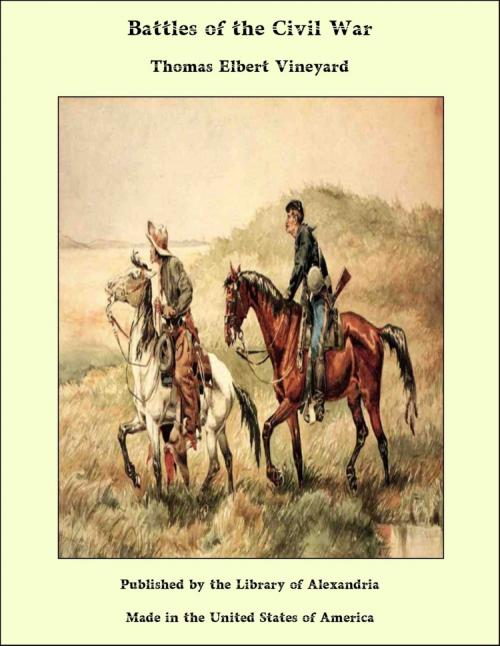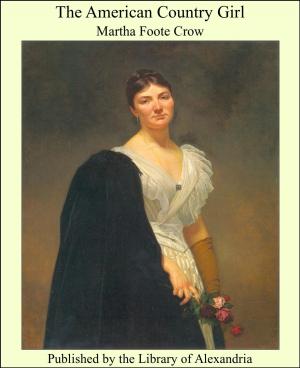Battles of the Civil War
Nonfiction, Religion & Spirituality, New Age, History, Fiction & Literature| Author: | Thomas Elbert Vineyard | ISBN: | 9781465610911 |
| Publisher: | Library of Alexandria | Publication: | March 8, 2015 |
| Imprint: | Language: | English |
| Author: | Thomas Elbert Vineyard |
| ISBN: | 9781465610911 |
| Publisher: | Library of Alexandria |
| Publication: | March 8, 2015 |
| Imprint: | |
| Language: | English |
At the beginning of July, 1861, the Federals had 30,000 men encamped along the Potomac near the heights of Arlington under the general command of General Winfield Scott, who was a veteran of the war of 1812, as well as the Mexican war, but who was at this time aged and infirm, and remained in Washington, and Brigadier-General Irvin McDowell was in immediate command of the army. Another 20,000 men lay at Martinsburg under General Patterson who like Scott was a veteran of the war of 1812 and of the Mexican war. At Manassas Junction, about thirty miles from Washington, lay the Confederate army under Brigadier-General Beauregard. General Joseph E. Johnston was in command of 9,000 men in the Shenandoah Valley. Johnston and Beauregard, as well as McDowell, had with Scott and Patterson battled at the gates of Mexico. General Scott gave orders to McDowell to move against Beauregard and on the 16th day of July the army, with waving banners and lively hopes of victory, and with "On to Richmond" as their battle cry, moved on Manassas. General McDowell brought his army to a halt at Centreville within seven miles of Manassas. Beauregard was apprised of the coming of the Federals. The stream of Bull Run, from which the first great battle of the war derived its name, flowed between the two armies. Patterson failed to detain Johnston in the valley, and General Johnston reached Manassas with his army on the afternoon of the 20th. General Longstreet was also there, who some months later played a distinctive part in the struggle at Gettysburg and in the death grapple of Lee and Grant in the wilderness. McDowell, after resting his troops for two days at Centreville, thought the time for an engagement was now at hand, so on Sunday, July 21st, at half-past two in the morning, the men were roused for the coming conflict. Their dream of easy victory had already received a rude shock, for on their second day at Centreville a skirmish between two minor divisions of the opposing armies resulted in the defeat of the Union forces with some loss. Ambrose E. Burnside and William T. Sherman were at this time subordinate officers under General McDowell. Burnside, who figured later in the far more disastrous battle of Fredericksburg, and Sherman, distinguished for his march to the sea. The Union plan was that General Tyler should lead his division westward and cross Bull Run at the Stone Bridge about four miles from Centreville, and the remainder of the army under Hunter and Heintzelman was to make a circuit of several miles through a dense wood and cross Bull Run at Sudley's Ford. The plan was to attack the Confederate left wing. The march to Sudley's Ford was slower than expected and it was almost noon before this division of the army reached the field near Stone Bridge. General Tyler early in the day opened fire at Stone Bridge on the Confederates under General Evans, but merely kept up a desultory fire. As the morning wore away the Confederates suddenly discovered clouds of dust rising above the treetops along the Warrenton turnpike, which told them that the main Federal army was on them. Evans quickly turned about and made ready for battle and waited calmly for the approach of the enemy. Presently there was a glimmer of sunlight reflected from burnished steel among the trees and Colonel Burnside led the Federal army from the woods and without delay the battle began and raged furiously.
At the beginning of July, 1861, the Federals had 30,000 men encamped along the Potomac near the heights of Arlington under the general command of General Winfield Scott, who was a veteran of the war of 1812, as well as the Mexican war, but who was at this time aged and infirm, and remained in Washington, and Brigadier-General Irvin McDowell was in immediate command of the army. Another 20,000 men lay at Martinsburg under General Patterson who like Scott was a veteran of the war of 1812 and of the Mexican war. At Manassas Junction, about thirty miles from Washington, lay the Confederate army under Brigadier-General Beauregard. General Joseph E. Johnston was in command of 9,000 men in the Shenandoah Valley. Johnston and Beauregard, as well as McDowell, had with Scott and Patterson battled at the gates of Mexico. General Scott gave orders to McDowell to move against Beauregard and on the 16th day of July the army, with waving banners and lively hopes of victory, and with "On to Richmond" as their battle cry, moved on Manassas. General McDowell brought his army to a halt at Centreville within seven miles of Manassas. Beauregard was apprised of the coming of the Federals. The stream of Bull Run, from which the first great battle of the war derived its name, flowed between the two armies. Patterson failed to detain Johnston in the valley, and General Johnston reached Manassas with his army on the afternoon of the 20th. General Longstreet was also there, who some months later played a distinctive part in the struggle at Gettysburg and in the death grapple of Lee and Grant in the wilderness. McDowell, after resting his troops for two days at Centreville, thought the time for an engagement was now at hand, so on Sunday, July 21st, at half-past two in the morning, the men were roused for the coming conflict. Their dream of easy victory had already received a rude shock, for on their second day at Centreville a skirmish between two minor divisions of the opposing armies resulted in the defeat of the Union forces with some loss. Ambrose E. Burnside and William T. Sherman were at this time subordinate officers under General McDowell. Burnside, who figured later in the far more disastrous battle of Fredericksburg, and Sherman, distinguished for his march to the sea. The Union plan was that General Tyler should lead his division westward and cross Bull Run at the Stone Bridge about four miles from Centreville, and the remainder of the army under Hunter and Heintzelman was to make a circuit of several miles through a dense wood and cross Bull Run at Sudley's Ford. The plan was to attack the Confederate left wing. The march to Sudley's Ford was slower than expected and it was almost noon before this division of the army reached the field near Stone Bridge. General Tyler early in the day opened fire at Stone Bridge on the Confederates under General Evans, but merely kept up a desultory fire. As the morning wore away the Confederates suddenly discovered clouds of dust rising above the treetops along the Warrenton turnpike, which told them that the main Federal army was on them. Evans quickly turned about and made ready for battle and waited calmly for the approach of the enemy. Presently there was a glimmer of sunlight reflected from burnished steel among the trees and Colonel Burnside led the Federal army from the woods and without delay the battle began and raged furiously.















